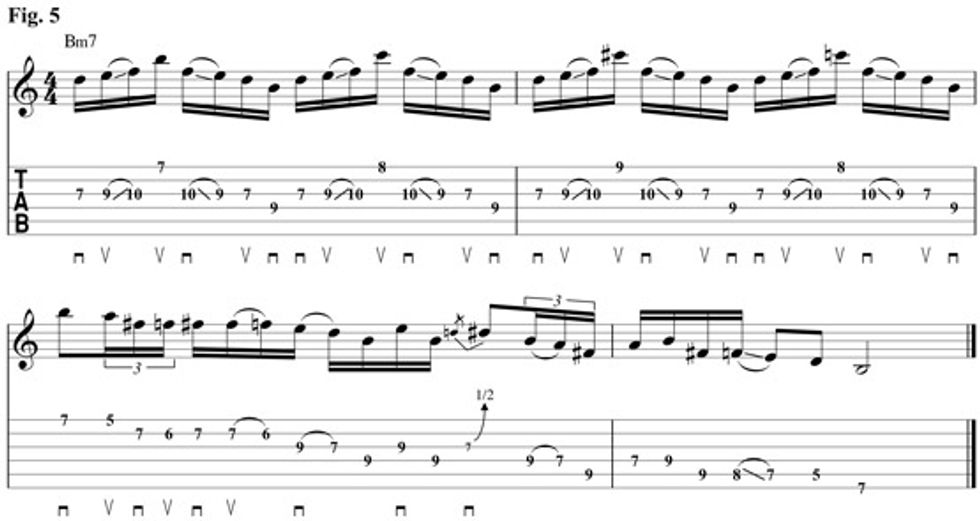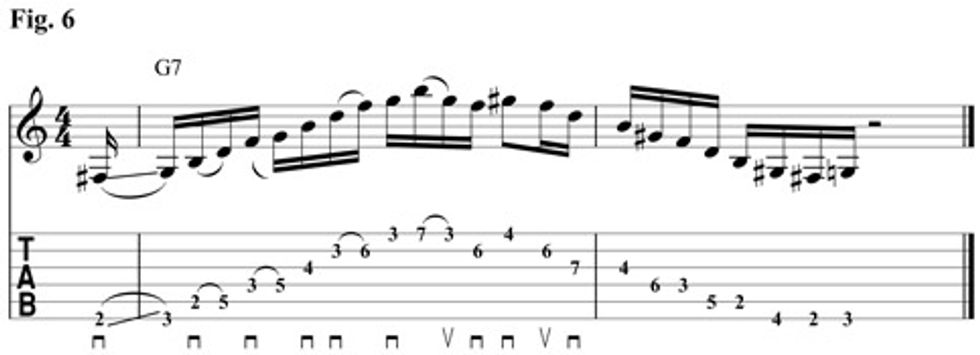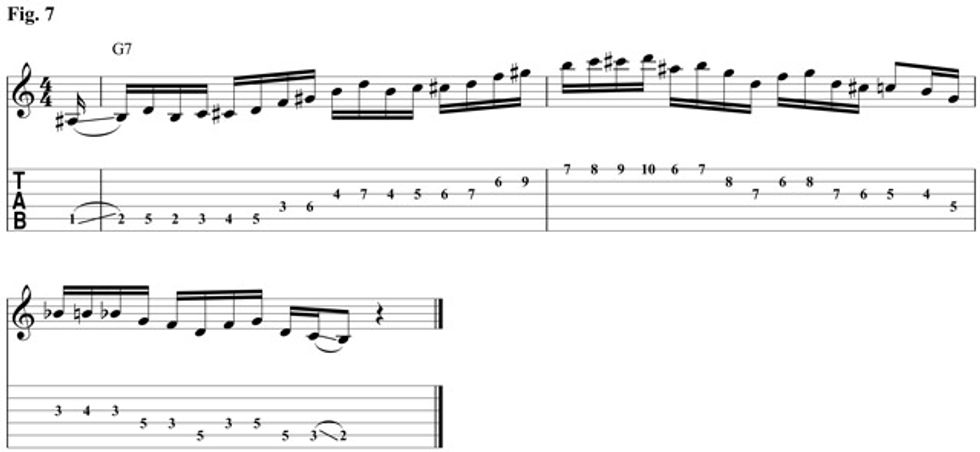Chops: Intermediate
Theory: Intermediate
Lesson Overview:
• Incorporate more “outside”
sounds into your playing.
• Learn to use half-diminished
and diminished arpeggios
over dominant chords.
• Create lines that combine chromaticism
and rock appeal.
As a guitarist, I’ve always been drawn to outside sounds. As a music enthusiast, I have always questioned their placement in the big picture. At times, inside-sounding lines can be boring just as much as outside-sounding lines can sound uncalled for. Since I’ve never really considered myself a straight ahead rock or jazz player, I try my best to let the music dictate which path to choose. One thing is for sure: Life is short and sounding typical should not be on anyone’s agenda.
One of my recurring thoughts usually involves the desire to develop a unique sound without losing what I like to refer to as “rock appeal.” With timing and the listener in mind, we can build the right tension that eventually resolves into a bigger musical statement. Is it possible to satisfy listeners and our inner guitarist simultaneously? One can only hope. In this column, I would like to shed some light on how to approach playing mildly outside of the diatonic key while still having a solid foundation for the listener to grasp onto.
Moderation towards outside playing can help things sound more composed and flowing during writing or improvising. The goal is to play our part, but not stand out to the point of being tasteless. In Fig. 1 I’m playing an E7b9 arpeggio (the V chord in the key of A), then resolving a whole-step bend up to the 9th. For a less intervallic sound, I’m walking down chromatically and ending the line with a whole-step bend to the root.

The half-diminished arpeggio that begins Fig. 2 is a very underestimated sound, especially in rock and metal. You can hear this approach used frequently on just about every recording I’ve ever been a part of. Starting a major 6th above the root emphasizes the F# without sounding too Dorian. I think the half-diminished arpeggio is less predictable than a fully diminished arpeggio, which is what attracts me to it. In the second measure I slide down into an Em7 arpeggio before ending the line with a half-step bend in to the 9th.

Using vertical movement, you can access an altered dominant chord while staying within the same fret radius. For Fig. 3, we’re ascending and descending through a dominant 7#5 arpeggio moving toward the downbeat of the second measure. To resolve it smoothly, I’m using a Dm(add9) arpeggio that is arranged horizontally. These sounds are very Gypsy-jazz inspired.

Every practicing musician should make it a goal to get more use out of smaller ideas. Manipulating an idea that sounds more cliché is a great starting point. One advantage of this approach is that we are basing our idea off of something more familiar to the listener—the blues. The motion of these often-used ideas can display just the right amount of weirdness to be entertaining, but not to scratch a record. This lick in Fig. 4 can easily be repeated or looped. Most ideas that can be looped are a great starting point for this approach. Now that we have established a motion, we can alter the notes to build even more tension.

Once we have gained the listener’s attention through repetition, we are going to move the root around to put an interesting spin on something we consider home. Notice the 9–b9–root movement in Fig. 5. You can let this motif rip and have the band building behind you to create more drama before releasing the tension through the blues scale.

Dominant chords are great for building tension. From a traditional V7-I cadence all the way to a 12-bar blues, having an existing tritone inside of a chord allows creative freedom. In Fig. 6 we use this idea over a G7 chord. This sound has become one of my favorites, especially when used in a traditional format. Playing a diminished arpeggio off of the major 3rd is a very interesting sound. It contains the primary and secondary chord tones along with the b9. A very obvious quality of the diminished arpeggio is its minor third movement. This can sound quite predictable if overused, so let’s find a creative way to dress it up.

Fig. 7 offers a slightly different approach, where I’m actually filling in the blanks of the same diminished arpeggio with chromaticism to create a sequenced sound. The even number of notes makes it very easy to play at faster tempos. Passing tones can really assist your picking hand while breaking you out of the “box.” A good rule of thumb: The more notes per string, the easier it is to alternate pick.

Once you have experimented with these ideas, be sure to pick and choose what works for your ears. When your ears have acclimated to these notes against a chord, you will begin to hear a whole new realm of possibilities. Sometimes getting the listener’s attention is just as important as a great composition. Sometimes adding to or altering what you already know is a lot more effective for building style than completely diving headfirst into something that may take a long time to incorporate. The goal is to be able to play both sides of the field while opening doors to new ideas and understanding.
 Emil Werstler is the lead guitarist for metal
bands Dååth and Chimaira. His Gypsy jazz-infused
lines can be heard on Levi/Werstler’s
Avalanche of Worms and records by Austrian
Death Machine and Xerath. Werstler is active
as a clinician and endorsee for Paul Reed
Smith Guitars and Xotic Effects, and he
teaches lessons in the Atlanta area. For more
information, visit emilwerstler.com.
Emil Werstler is the lead guitarist for metal
bands Dååth and Chimaira. His Gypsy jazz-infused
lines can be heard on Levi/Werstler’s
Avalanche of Worms and records by Austrian
Death Machine and Xerath. Werstler is active
as a clinician and endorsee for Paul Reed
Smith Guitars and Xotic Effects, and he
teaches lessons in the Atlanta area. For more
information, visit emilwerstler.com.

















